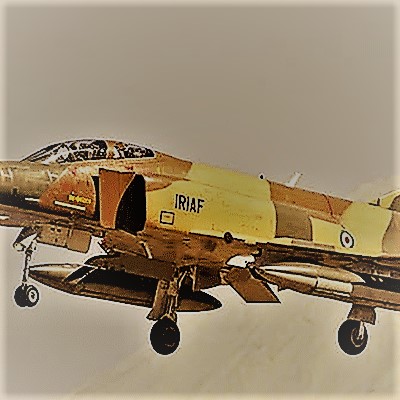Warfare
RF-4
Written by: Mohsen Shirmuhammad,
Translated by: Hadi Qorbanyar
78 دورہ
The RF-4 was a reconnaissance aircraft employed by the Iranian Army Air Force during the Iran–Iraq War for aerial photography of military targets inside enemy territory.
In 1963,[1] the American company McDonnell Douglas modified the Phantom (F-4) into the RF-4. This aircraft is almost identical to the fighter version, except for its nose where cameras and radar systems are installed. The RF-4 is equipped with a more advanced navigation system compared to the fighter version. As a reconnaissance aircraft, it does not carry any weapons and is incapable of engaging in aerial combat.[2] In the RF-4, the front-seat pilot operates the aircraft, while the rear-seat crew member handles photographic reconnaissance and navigational duties.[3]
The United States used the RF-4 extensively in the Vietnam War starting in 1967. At first, Washington refused to sell this advanced aircraft to allied countries. For example, during the Six-Day War (1967), the U.S. declined Israel’s request for the RF-4. Instead, American pilots flew these aircraft from bases in Germany to conduct aerial reconnaissance over the conflict zone on behalf of the Israeli military.[4]
In 1971, Iran purchased its first RF-4s from the United States, and eventually a total of 16 were delivered, significantly strengthening the country’s aerial reconnaissance capability.[5] These aircraft were also deployed by Iran during the Dhofar campaign in Oman (1973–1976) to carry out reconnaissance missions.[6]
By September 1980, just before the outbreak of the Iran–Iraq War, eight RF-4s were stationed at Mehrabad Air Base, ready for missions, and supported by seven front-seat pilots and 17 back-seat specialists in reconnaissance and navigation.[7]
On September 23, 1980, one day after Iraq launched its first air raid on Iran, the Iranian Air Force carried out large-scale retaliatory strikes against Iraqi military bases.[8] To assess the results of these operations, the first reconnaissance flights using RF-4 aircraft were conducted over Habbaniyah Air Base in Iraq, where photographs were taken of the bombed areas.[9]
Among the key aerial reconnaissance systems of the RF-4 was the KA-90B panoramic camera with a 24-inch lens, designed for high-altitude imaging. This equipment proved essential in key operations[10] as it enabled Iranian forces to photograph the Lejman line (the forward edge of the battlefield) and evaluate the latest positions of Iraqi troops.[11]
The RF-4s played a decisive role in major operations during the war, including Thamen al-Aemmah (as) (September 1981),[12] Fath al-Mubin (March 1982),[13] Beit al-Muqaddas (April–May 1982),[14] and Valfajr 8 (February 1986).[15] For instance, in Operation Thamen al-Aemmah (as) reconnaissance flights were conducted, and the photographs—along with their attachments—were sent by Falcon jet to Omidieh Air Base in Ahvaz. Then, they were transported overland to the 77th Army Division headquarters near Mahshahr, where intelligence officers of the division analyzed the images.[16]
Operational security was a constant concern in RF-4 missions. To protect flight information, sometimes even radar operators were not informed of the aircraft’s true destination after takeoff.[17] At the beginning of the war, RF-4s penetrated Iraqi airspace covertly, flying at low altitude and usually in single-aircraft missions.[18] However, from the mid-years of the war, reconnaissance became increasingly difficult with the arrival of advanced Iraqi aircraft such as Mirage and MiG-25, as well as the introduction of modern air defense systems like Roland. In many cases, reconnaissance flights had to be canceled due to either enemy awareness of planned operations or unfavorable weather conditions, and missions were postponed and repeated on subsequent days.[19]
Several RF-4 pilots were martyred during the war, including Fereydoun Zolfaqari, Muhammad-Reza Norouzi,[20] Ali-Reza Daryanian, Gholamreza Khosropour, Hamid-Reza Naderinia, Masoud Kourosh, and Gholamabbas Soltani.[21]
After the war, in late summer 1988, the RF-4 fleet was transferred from Mehrabad Air Base to Shahid Nojeh Air Base in Hamadan.[22] In August 1989, specialists of the Iranian Army Air Force successfully installed an aerial refueling system on the RF-4, enabling it to refuel from Boeing 707 tankers.[23] In 1995, an RF-4 that had sustained severe damage during a hard landing in 1977 was fully restored and returned to service by the Iran Aircraft Industries Organization.[24]
On October 29, 2003, however, an RF-4 encountered a technical malfunction during a training flight near Zanjan. It crashed around Ijroud, Zanjan Province, and both of its pilots were martyred.[25]
[1] Gunston, bill, SPY PLANES, New York, Arco Military Book, 1988, p. 44.
[2] Shirmuhammad, Mohsen, Gordan 11 Shenasayi-ye Rahkoneshi-ye Niruye Havaei dar Defa Muqaddas (11th Tactical Reconnaissance Squadron of the Air Force in the Sacred Defense), Mahnameh Saf, No. 433, Tir 1396, p. 35.
[3] Shirmuhammad, Mohsen, Tanha dar Aseman: Goftogu ba Sartip Dovom Khalaban Mahmoud Kangarlo (Alone in the Sky: A Conversation with Second Brigadier Pilot Mahmoud Kangarlo), Bakhsh-e Nokhost, Mahnameh Sanaye Havaei, No. 352, Mordad 1401, p. 12.
[4] Shirmuhammad, Mohsen, Gordan 11 Shenasayi-ye Rahkoneshi-ye Niruye Havaei dar Defa Muqaddas (11th Tactical Reconnaissance Squadron of the Air Force in the Sacred Defense), p. 35; Shirmuhammad, Mohsen, Cheshman-e Oqab: Hamaseh-ye Gordan 11 Shenasayi-ye Taktiki-ye Niruye Havaei va Amaliat-e Aksbardari-e Havaei dar Defa Muqaddas (Eagle Eyes: The Epic of the 11th Tactical Reconnaissance Squadron of the Air Force and Aerial Photography Operations in the Sacred Defense), Tehran, Markaz Entesharat Rahbordi-ye NAHAJA, 1396, p. 28.
[5] Shirmuhammad, Mohsen, Gordan 11 Shenasayi-ye Rahkoneshi-ye Niruye Havaei dar Defa Muqaddas Muqaddas (11th Tactical Reconnaissance Squadron of the Air Force in the Sacred Defense), p. 83.
[6] Shirmuhammad, Mohsen, Cheshman-e Oqab: Hamaseh-ye Gordan 11 Shenasayi-ye Taktiki-ye Niruye Havaei va Amaliat-e Aksbardari-e Havaei dar Defa Muqaddas (Eagle Eyes: The Epic of the 11th Tactical Reconnaissance Squadron of the Air Force and Aerial Photography Operations in the Sacred Defense), Pp. 103, 105.
[7] Goruh-e Moalefin, Tarikh-e Nabardha-ye Havaei-ye Defa Muqaddas, Vol. 1: ta Aghaz-e Tahajom-e Sarasari-ye Araq (History of Aerial Battles of the Sacred Defense, Vol. 1: Until the Beginning of Iraq’s Full-Scale Invasion), Tehran, Markaz Entesharat Rahbordi-ye NAHAJA, Ch. 1, 1393, p. 389.
[8] Shirmuhammad, Mohsen, Cheshman-e Oqab: Hamaseh-ye Gordan 11 Shenasayi-ye Taktiki-ye Niruye Havaei va Amaliat-e Aksbardari-e Havaei dar Defa Muqaddas (Eagle Eyes: The Epic of the 11th Tactical Reconnaissance Squadron of the Air Force and Aerial Photography Operations in the Sacred Defense), p. 136.
[9] Ibid., p. 137.
[10] Shirmuhammad, Mohsen, Gordan 11 Shenasayi-ye Rahkoneshi-ye Niruye Havaei dar Defa Muqaddas (11th Tactical Reconnaissance Squadron of the Air Force in the Sacred Defense), p. 33; Shirmuhammad, Mohsen, Cheshman-e Oqab: Hamaseh-ye Gordan 11 Shenasayi-ye Taktiki-ye Niruye Havaei va Amaliat-e Aksbardari-e Havaei dar Defa Muqaddas (Eagle Eyes: The Epic of the 11th Tactical Reconnaissance Squadron of the Air Force and Aerial Photography Operations in the Sacred Defense), p. 83.
[11] Shirmuhammad, Mohsen, Cheshman-e Oqab: Hamaseh-ye Gordan 11 Shenasayi-ye Taktiki-ye Niruye Havaei va Amaliat-e Aksbardari-e Havaei dar Defa Muqaddas (Eagle Eyes: The Epic of the 11th Tactical Reconnaissance Squadron of the Air Force and Aerial Photography Operations in the Sacred Defense), Pp. 180–184.
[12] Shirmuhammad, Mohsen, Gordan 11 Shenasayi dar Amaliat-e Shekast-e Hasr-e Abadan (11th Reconnaissance Squadron in the Operation to Break the Siege of Abadan), Faslnameh Eqtedar-e Havaei, No. 13, Tabestan & Paeez 1400, Pp. 29–30.
[13] Shirmuhammad, Mohsen, Cheshman-e Oqab: Hamaseh-ye Gordan 11 Shenasayi-ye Taktiki-ye Niruye Havaei va Amaliat-e Aksbardari-e Havaei dar Defa Muqaddas (Eagle Eyes: The Epic of the 11th Tactical Reconnaissance Squadron of the Air Force and Aerial Photography Operations in the Sacred Defense), Pp. 205–207.
[14] Ibid., Pp. 210–213.
[15] Ibid., Pp. 242–245.
[16] Shirmuhammad, Mohsen, Gordan 11 Shenasayi dar Amaliat-e Shekast-e Hasr-e Abadan (11th Reconnaissance Squadron in the Operation to Break the Siege of Abadan), Pp. 29–30.
[17] Shirmuhammad, Mohsen, Cheshman-e Oqab: Hamaseh-ye Gordan 11 Shenasayi-ye Taktiki-ye Niruye Havaei va Amaliat-e Aksbardari-e Havaei dar Defa Muqaddas (Eagle Eyes: The Epic of the 11th Tactical Reconnaissance Squadron of the Air Force and Aerial Photography Operations in the Sacred Defense), p. 209.
[18] Ibid., p. 252.
[19] Ibid., Pp. 252–254.
[20] Ibid., p. 245.
[21] Ibid., Pp. 141, 223, 227, 229, 260.
[22] Ibid., p. 269.
[23] Ibid., Pp. 205–207.
[24] Ibid., Pp. 115–117.
[25]Ibid., Pp. 274–275.



